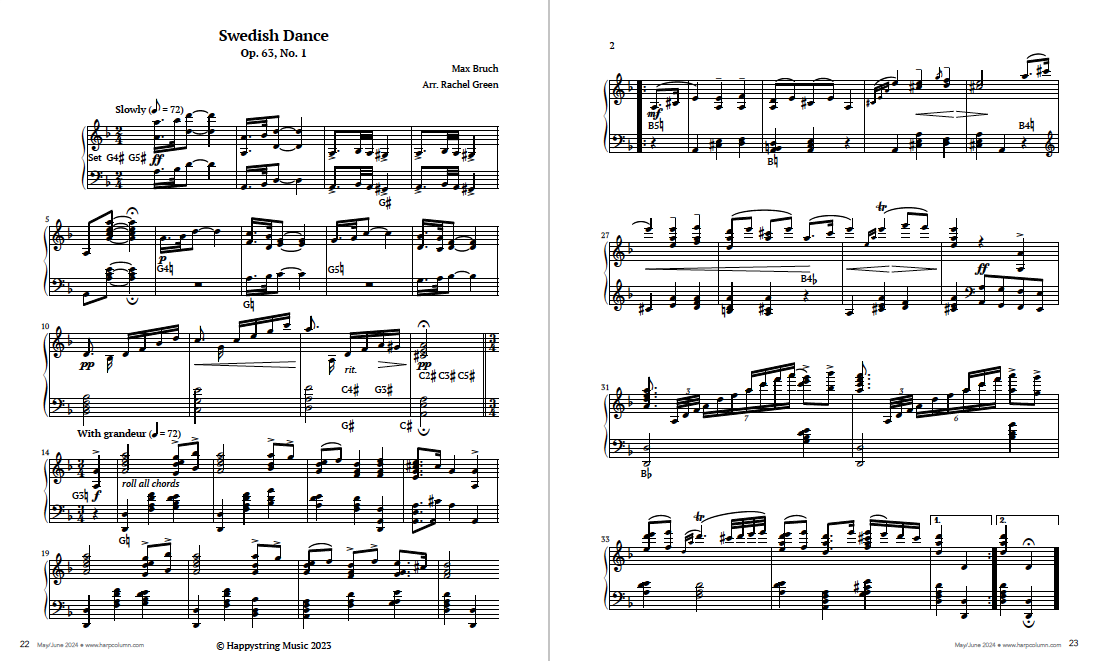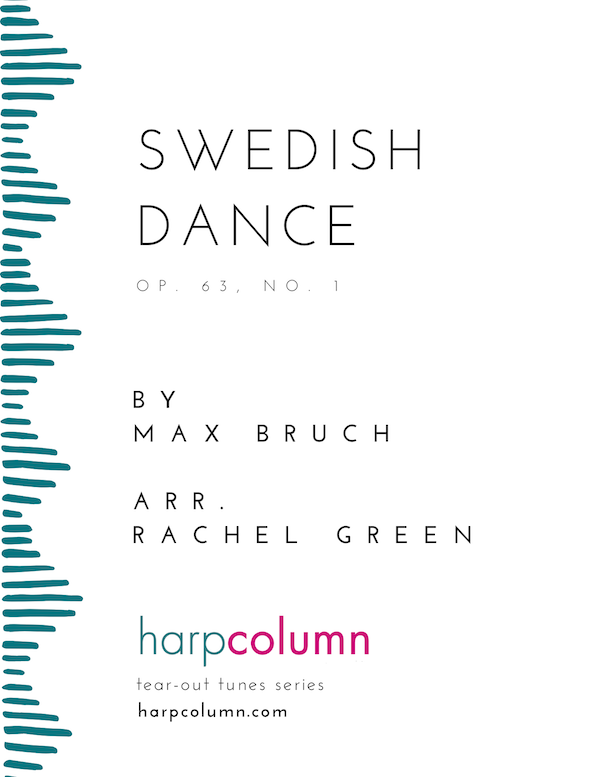
Download this issue to get this tune now!
Each installment of our Tear-Out Tunes series features a new piece written by one of the best harpist-composer-arrangers in the business. Each composer will tell you a little bit about their piece, and also give you some helpful tips for learning it and getting the most out of the experience. The new piece (on the following pages) is yours to keep. We even put it right in the middle of the magazine so you can tear out the whole sheet and put your new tune on your music stand.
Whenever I listen to pieces composed for other instruments, in the back of my mind, I wonder, “Could this piece sound good on harp?” The radio has been the inspiration for several pieces that I have arranged. My other favorite way to discover new pieces is by browsing IMSLP, as I did for Max Bruch’s Swedish Dance, Op. 63, No 1. Opus 63 is a collection of 15 dances that Bruch originally wrote for violin and piano, later creating three additional arrangements of the dances for orchestra, piano for four hands, and piano solo. In creating this arrangement for harp, I primarily worked from the solo piano score. There are three principles that guide choices I make when arranging: make it accessible, make it playable, and make it harpistic.
Make it accessible
Making a piece accessible includes making it as easy to read as possible. In m. 1 of Swedish Dance, Bruch wrote the last note of the measure as a dotted quarter note, receiving one and a half beats in the 2/4 meter. Rather than keep Bruch’s notation, I rewrote that note as an eighth note tied to a quarter note, depicting more clearly where beat two occurs.
In m. 27 and many other measures, there are two voices in the bass clef. A pianist would play the C-sharp on beat one and hold it down while playing the E and A on beat two. Thus, indicating the C-sharp as a half note is necessary. On harp however, you merely pluck the C-sharp and move on to the next note. Thus, I wrote all the notes in one voice as quarter notes. While specific voice leading can be essential in pieces like fugues, in this case I prioritized accessibility over keeping the specific voice leading.
Make it playable
The art of arranging scores for harp could be described as the art of deletion. Rather than overlooking pieces that don’t work as originally written due to their chromaticism or sheer quantity of notes, we can still enjoy many pieces by deleting whichever parts don’t work. In Bruch’s Swedish Dance, there are places where I delete individual notes, entire chords, and even entire measures.
In mm. 3–4, Bruch includes two 32nd notes at the end of the measure: F-double-sharp and G-sharp, followed by the A on the following downbeat. There is no lever or pedal setup that accommodates these three notes, thus I deleted the F-double-sharp and G-sharp altogether.
In m. 25 and m. 29, once again the chromaticism as originally written involves multiple lever changes. In this case, I took out the G-sharp and B-flat on beat three. Instead of a dim7 chord, the remaining two notes function as upper neighbor tones. While the neighbor tones certainly have less tension than a dim7 chord, it works!
At the end of Swedish Dance, Bruch includes a number of spicy chromatic chords in a brilliant, flashy ending. If you played through my arrangement before reading this article, I’m guessing the thought never crossed your mind that something could be missing. But now you realize that three whole measures have vanished (originally mm.34–36). Wait, is that allowed? Of course! Consider how the deletion of three measures allowed an entire new piece to be added to the lever harp repertoire.
Make it harpistic
The final key to making a good transcription is to make it harpistic. There are certain chord voicings and patterns that are idiomatic to our instrument. In the A-major chord in m.13, Bruch writes a C-sharp an octave below middle C, just a third above the bass A. I changed the voicing on this chord as the thick gut strings of the harp resonate so much it can be hard to hear distinct pitches. In my arrangement, the C-sharp is an octave higher, leaving a fifth between the A and E at the bottom of the chord.
On harp, two-handed arpeggios are much easier to play than one-handed arpeggios. While an advanced harpist may be able to play exactly what Bruch wrote in mm. 31-32, I decided to take out the left-hand chord on beat two, allowing the harpist to play the arpeggio with both hands. In addition, I deleted the lowest note on beat three in m. 31 (G2), as reaching down for that note created a risk for buzzing. Similarly, I deleted the middle note of beat three in m. 32 (D2) as this note was played two notes earlier. This allows for an easier placement and avoids a stopped string sound.
Swedish Dance is a delightful piece, and I am excited to share this version with the harp community. Enjoy! •








